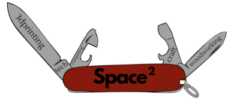If you are not 100% sure whether a material is safe or not, please just ask someone rather than taking a chance!
Allowed #
- Laser-safe MDF
- Laser-safe plywood
- Blocks of actual wood (pine, balsa, poplar, birch, etc.). Beware of very resinous wood, since it might cause a fire!
- Paper (Cut only, don’t engrave!)
- Card/Cardboard
- Acrylic/Perspex – Clear/blue-coloured acrylic will not be affected by the blue light of the diode laser!
- Foamcore (non-PVC variety)
- Correx (Genuine non PVC)
- Depron foam (Fire risk, must be closely monitored)
- Cloth/felt/hemp/cotton (Not plastic-impregnated fabric)
- Leather (not fake or PVC). The smell is incredibly bad, so ask anyone else in the space before you start lasering it!
- Stone
- CO2 laser: Engrave only
- Ceramic tile
- CO2 laser: Engrave only
- Glass
- CO2 laser: engrave only
- Anodized Aluminium
- CO2 laser: engrave only
- Stainless steel
- CO2 laser: engrave only (will leave a dark shadow)
- Diode laser: engrave in colours or cut up to 0.05mm
Banned #
- Manufactured wood sheets (ply, MDF, OSB, etc.) which aren’t explicitly laser-safe. These products contain relatively high levels of formaldehyde which is toxic.
- Food
- Body parts
- PVC: Also known as “vinyl” “pleather” “artificial leather.” Emits pure chlorine gas when cut! Don’t ever cut this material as it will ruin the optics, cause the metal of the machine to corrode, and ruin the motion control system.
- ABS plastic: ABS does not cut well in a laser cutter. It tends to melt rather than vaporize, and has a higher chance of catching on fire and leaving behind melted gooey deposits on the vector cutting grid. It also does not engrave well (again, tends to melt). Finally, ABS emits cyanide when cut.
- Fibreglass: It’s a mix of two materials that can’t be cut. Glass (etch, no cut) and epoxy resin (fumes)
- Circuit boards
- Polycarbonate: Also known as “Lexan”, polycarbonate is also often found as flat, sheet material. The case cover window on the laser cutter is made of Polycarbonate because polycarbonate strongly absorbs infrared radiation! This is the frequency of light the laser cutter uses to cut materials, so it is very ineffective at cutting polycarbonate. Polycarbonate can also emit flame and chlorine gas when cut, making it a poor choice for laser cutting.
- All other metal (except engraving anodized aluminium or stainless steel)
- Polystyrene foam: It catches fire, it melts, and only thin pieces cut. This is the #1 material that causes laser fires!!!
- Polypropylene foam
- Delrin: Also known as Polyoxymethylene, or Acetal. Very handy polymer material, lathes well, and is very stable with respect to moisture and humidity. When burned it produces Formaldehyde gas. Even with the extraction systems at LAMM this material isn’t allowed near the lasers.
- HDPE: “milk bottle” plastic. It melts. It gets gooey. It catches on fire. Don’t use it.
- Carbon fibre
- Coated carbon fibre: Again, it’s a mix of two materials. Thin carbon fibre mat can be cut, with some fraying. However, once coated with epoxy it will emit noxious fumes.
You should only be cutting materials on the Allowed list, if you want to cut a material which is not on this list, contact one of the maintainers and get them to OK it first.




